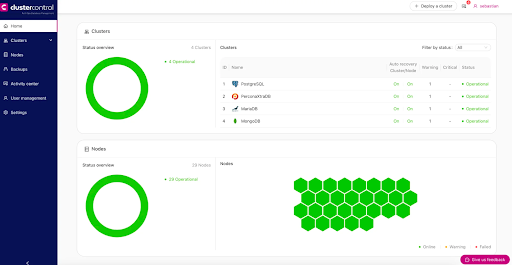blog
Importance of a cloud exit strategy and how to plan one

Nowadays, cloud computing has become an integral part of many companies. It offers flexibility, scalability, and cost-effectiveness. However, despite the numerous benefits, it is crucial for businesses to have a cloud exit strategy in place.
This strategy ensures a smooth transition from the cloud environment to another provider or even to an on-prem infrastructure if circumstances demand it. In this blog post, we will explore the significance of a cloud exit strategy and how to plan one.
What is a cloud exit strategy?
A cloud exit strategy is a set of actions put in place by an organization to transition its data, applications, and services from a cloud computing environment back to an on-prem infrastructure or to another cloud provider. It is essentially a contingency plan that ensures the organization can smoothly and efficiently disengage from its current cloud service provider if needed.
Top reasons you should have a cloud exit strategy
There are many reasons why an organization might need a cloud exit strategy. Let’s see some of them.
Cost savings
Depending on the usage, it could be possible that your traffic increases more and more every day and, as the demand grows, so do the costs, and you might find yourself in a situation where monthly cloud expenses become too high, and the negatives soon outweigh the benefits of operating in the cloud.
Compliance
Changes in regulations or legal requirements may need something that you can’t get in the current cloud provider, so you will need to migrate to another one or even to an on-premises environment to ensure compliance and data sovereignty.
Performance
You may need to move your systems to have a better geo-distribution topology to increase performance, or even to mitigate problems with the current cloud provider, such as worse service quality, frequent network issues, or slowness caused by insufficient resources or poor hardware.
Data sovereignty
Data privacy regulations and compliance requirements continue to evolve. Organizations need to ensure their data is stored and processed in accordance with applicable laws. A cloud exit strategy allows businesses to regain control over their data and comply with any necessary regulations, such as data residency requirements.
DRP and cloud outages
In the case of the cloud provider going down, I know, the probability is low but it is not 0 and it is a risk that you should consider in a DRP, so in that case, you will need a cloud exit strategy to avoid downtime.
Cloud providers also offer many options for implementing a Disaster Recovery Plan like High availability, redundancy, and backups but sometimes it is not enough, and if you are using only the tools offered by the cloud provider you may fall into a vendor lock-in trap.
Vendor lock-in
Using products owned by or existing only in a specific cloud provider might be a significant problem if an organization wishes to change providers or if a provider goes out of business. This can be mitigated by having a cloud exit strategy using open-source technologies and standardization of the cloud environments.
How to plan a cloud exit strategy
The plan of a cloud exit strategy depends on the business requirements and they change for each company. As a basic approach, you can follow these steps:
1. Document the current environment
To know what to do you need to know what you have, so as a starting point you should collect information and document the current environment, in case you don’t have it yet. It means, understanding the existing infrastructure, services, and dependencies and documenting critical information such as data locations, dependencies, configurations, and contractual obligations.
2. Identify alternative solutions
Research and evaluate potential alternatives, such as moving to another cloud provider or transitioning back to an on-prem environment. Consider factors like cost, scalability, performance, security, and compatibility with existing systems.
3. Contractual and legal considerations
Review existing contracts and agreements with the current cloud provider, including terms related to termination, data ownership, and data retrieval. Understand any potential costs, penalties, or limitations associated with ending the relationship.
4. Data and application migration planning
Determine the migration strategy and roadmap. Assess data transfer methods, potential downtime or service interruptions, and compatibility between the existing and target environments. Plan for any necessary data transformation, restructuring, or reformatting.
5. Test the migration plan
Emulate the migration process in a test environment. Ensure that proper testing, validation, and verification procedures are in place to mitigate risks and minimize downtime when you run it in production.
By having a well-defined cloud exit strategy, organizations can minimize disruptions, maintain data integrity, and effectively transition from one cloud provider to another or from the cloud to an on-prem environment, if necessary but, it is not an easy task so some help could be useful and here is when systems like ClusterControl enter in action.
How ClusterControl supports a cloud exit strategy
ClusterControl is a management and monitoring system that helps to deploy, manage, monitor, and scale your databases from a user-friendly interface. You can automate many database tasks you must regularly perform, like adding new nodes, running backups and restores, and more.
It supports different database technologies in different environments, no matter where you are running it and it is not necessary to have all the database nodes running in the same place.

In case you are planning a cloud exit strategy, you can take advantage of all the ClusterControl features to help in the process.
Deployment and management
With ClusterControl, you can create your database cluster using the deploy feature. Simply select the option “Deploy” and follow the instructions that appear.
Here, you will find all your database clusters on the same platform, no matter where they are deployed or what technology you use. It supports database vendors like Percona, MariaDB, PostgreSQL, and more. You can clone your existing cluster and run it in a different provider with only a couple of clicks.
Also, you can add new nodes in a different provider and promote them after everything is in place to minimize downtime.
Note that if you already have a cluster running, you must select the “Import Existing Server/Database” instead if you already have the server instances created in the provider or on-prem. In case you want ClusterControl to create the instances in a cloud provider for you, you can use the “Deploy in the Cloud” feature, which will use an AWS, Google Cloud, or Azure integration to create the VMs in the cloud, and you don’t need to access the cloud provider management console at all.
Vendor lock-in
As ClusterControl deploys and uses open-source technology, you don’t need to worry about vendor lock-in. Everything that you run/deploy with ClusterControl, like backups or load balancers, is open-source software, so you can install it wherever you want, and you don’t need to use any specific cloud provider or environment.
Security
Even when ClusterControl can’t configure access to your database nodes beforehand, it uses SSH connections with SSH Keys to manage your database clusters securely. So, even in different environments, connections and traffic between ClusterControl and the different providers will be safe.
It can manage your database users, so you can restrict access to your cluster from some specific sources. Also, you can create custom templates for deploying your databases, so you don’t need to depend on the provider configurations.
Audit and encrypt features are available for some database technologies. You can enable and use them from the same platform and avoid using the provider’s features if it has them.
Monitoring
ClusterControl allows you to monitor your servers in real time with predefined dashboards to analyze some of the most common metrics. It allows you to customize the graphs available in the cluster, and you can enable agent-based monitoring to generate more detailed dashboards. You can also create alerts that inform you of events in your cluster or integrate with different services such as PagerDuty or Slack.
High availability and scalability
After you have the cluster managed by ClusterControl, you can easily add new database nodes, load balancers, or even run failover tasks from the same system and change or improve your database topology as you wish.
Auto-recovery
One of the most important features of ClusterControl is the Auto-Recovery feature. It will allow you to recover your cluster in case of failure in an automatic way and let you know if it happens by sending notifications and showing alarms.
Backups
ClusterControl has many advanced backup management features that allow you not only to take different types of backups, in different ways, but also compress, encrypt, verify, and even more.
The automatic backup verification tool is also useful to make sure that your backups are good to use if needed and avoid problems in the future.
S9S-Tools
S9S-Tool is a command-line tool to interact, control, and manage database clusters using the ClusterControl Database Platform. Starting from version 1.4.1, the installer script will automatically install this package on the ClusterControl node. You can also install it on another computer or workstation to manage the database cluster remotely. Communication between this client and ClusterControl is encrypted and secure through TLS. This command-line project is open source and publicly available on GitHub.
S9S-Tool opens a new door for cluster automation where you can easily integrate it with existing deployment automation tools like Ansible, Puppet, Chef, or Salt.
Conclusion
Having a cloud exit strategy is critical for any organization. It allows businesses to proactively manage risks, maintain data sovereignty, and adapt to evolving business needs.
By following the steps outlined in this blog post and with the help of ClusterControl, businesses can plan and execute a seamless transition from one cloud provider to another or from the cloud to an on-premises environment.
Want to take ClusterControl’s UI for a test drive? Check out our no-commitment sandbox environment here. In the meantime, follow us on LinkedIn and Twitter to keep pace with the evolving database, orchestration tooling, and environment landscape.




